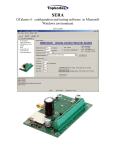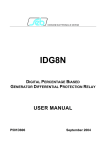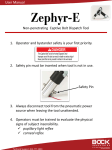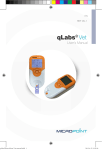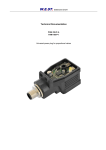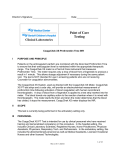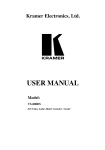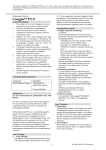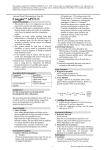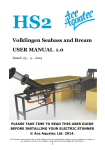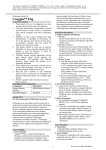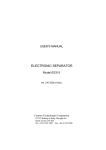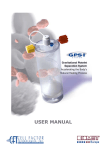Download hiClot - hiLab
Transcript
hiClot User Manual version March 19th , 2010 Chapter 1 General information 1.1 Layout of the device hiClot is a single channel low cost clot meter, very simple to use and capable of performing the most common clot assays. PT PTT TT FIB Prothrombin time Partial thromboplastin time Thrombin time Fibrinogen (Clauss) A piece of software is available1 for connecting the hiClot to an external computer in order to manage an archive of the assay results and to print reports. It is a small box that has an LCD back lit display, a keyboard and 12 positions to preheat the samples 2 positions for the reagents 1 reading well 1 The most recent version of this package can be downloaded from www.hilab.it hiClot user manual hiClot right side 4 General information The device can be controlled by means of a three button keyboard and the display on top of it. The power switch and the plug for the external supply on the right side, the connector of the PC interface is on the left side. 1.2 Structure of the instrument hiClot left side The hiClot upper side has the control panel and the thermostatic block. 1.2.1 Thermostatic block The thermostatic block is made of aluminum and has some wells to preheat the samples and the reagents as well as the reading station. It is covered with a plastic surface to lower its dissipation thus assuring temperature uniformity which is between 36, 5o C and 37, 5o C. The central well incorporates the optical reader and is where to insert the reaction cup to hiClot user manual 1.3 Working principle 5 be read. 1.2.2 Control panel The control panel is composed by an alphanumeric LCD display and a three button keyboard. It is seldom used during the normal work as it serves only to select the assay type and start the assay. and select the items of a list The two upper keys while the lower one accepts the current selection. OK 1.3 Working principle All the clot assay determine chain reactions that end by transforming the Fibrinogen into Fibrin using Thrombin as a catalyst. The Fibrin forms a high turbidity jelly clot that can be monitored by measuring the absorbance augmentation. hiClot user manual 6 General information Actually, hiClot is fundamentally a mono channel blue light colorimeter that can be schematized as follows. The semitransparent cup is crossed by the light beam generated by the emitter whose intensity variation is measured by the optical sensor on the opposite side. The assay sequence begins by inserting a cup into the measuring well containing the needed volume of sample. The cup insertion is revealed by the photometer. When the key is pressed, a three second count down begins at the end of which the operator adds the reagent: from now on, hiClot starts monitoring the clot formation. The typical absorbance graph after the reagent addition is shown in the following plot. OK 250 200 150 100 50 0 0 5 10 t (sec) 15 20 hiClot user manual 1.3 Working principle 7 For about ten seconds nothing happens, then after 12 ÷ 13 seconds the sample starts clotting and the absorbance raises as it is clearly seen in the figure2 . As the Fibrin is being synthesized the absorbance raises until the upper limit that corresponds to the total clot formation. hiClot follows completely the absorbance curve and builds the straight segments that control the stopwatch. This results in a good repeatability and improves hiClot insensibility to external disturbances. 2 Please note that the vertical absorbance scale is arbitrary. hiClot user manual Chapter 2 Assays 2.1 Basics Whet switched on, hiClot shows its name and the software version for a while, then automatically starts heating the measurement block up to 37o C. During the heating phase, lasting for about 5 ÷ 8 minutes depending on the external temperature, it displays an arrow that moves slowly rightwards as the temperature rises. When the heating is over, the message Insert sample is shown on the upper row and on the second the method list begins with PT PTT and continues rightwards as implied by the arrow. Please note that PT is surrounded by square parentheses to show that it is the current method, i.e. the one the instrument is ready to execute. You can change the current method by means of the and keys. Pressing the selection goes to the next method: in the middle of the row now the PTT method is surrounded by the hiClot user manual 2.1 Basics 9 parentheses. Pressing once more, the selection goes to the subsequent method (now TT is among parentheses). Please note that the arrow to the right disappears so we are at the end of the list while an arrow is now to the left since the head of the list is no more shown. Pressing goes back and the previous method is selected. The methods are ordered as follows: PT, PTT, TT e FIB. In order to start an assay, a cup must be inserted into the measurement well: the photometer reveals its presence and starts waiting for the reagent dispensation. Now the display shows the selected method and Reagent. If the instrument is not calibrated for the chosen method, an asterisk is shown: in such case no other result but the clot formation time will be delivered. Press and the displays shows a three second countdown. Insert the reagent when the countdown ends. the stopwatch starts an it will stopped by the clot formation. After that the instrument shows the time and, if calibrated, the calculated results depending on the chosen method as indicated by the following table. OK test PT P PTT TT FIB parameter Prothrombin time Ratio = P T /P Tpool INR = RatioISI Activity Partial Prothrombin time Ratio = P T T /P T Tpool Thrombin time Ratio = T T /T Tpool Derived Fibrinogen Concentration sec % sec sec sec mg/dl display XXX.X XX.XX XX.XX XXX.X XXX.X XX.XX XXX.X XX.XX XXX.X XXX. The last column to the right contains the significant figures: for instance XXX.X means that the result will be shown hiClot user manual 10 Assays by means of a number having one decimal figure and up to three figures before the decimal point (example 12.3) If you take out the cup from the reading well during the clot formation, the measurement is interrupted and hiClot sets for a new reaction. The maximum time for the clot formation is 300 sec after which the test is anyway interrupted. For the PT, PTT and TT assays, the ratio computations needs the P Tpool , P T Tpool and T Tpool coefficients that should be determined on a pool of sera that represents well the healthy population of the laboratory. 2.2 PT - Prothrombin time The Prothrombin or factor II is a glycoprotein synthesized by the liver whose concentration in plasma is 10 ÷ 16 mg/dl. The PT test detects the activity of the coagulation factors of the extrinsic pathway specifically the I,II, V, VII ad X some of which are influenced by the oral anticoagulant therapy. For this reason the PT assay is used for monitoring patients under such therapy. 2.2.1 Assay execution Select the PT method1 Preheat the PT reagent in a reagent well. Insert a hollow cup in a preheating well. Put 100 µL of sample in it (plasma) Preheat the sample for at least 2 min or the time indicated on the reagent box. 6. Move the cup in the reading well: the system automatically senses its presence and asks the operator to insert 1. 2. 3. 4. 5. 1 The selected method is the one between parentheses on the second row of the display. Select it by means of the and hiClot user manual 2.2 PT - Prothrombin time 11 the reagent. 7. Press : a three second countdown starts. When it is over, dispense 200 µL of preheated reagent into the sample cup and the timer starts. 8. Once the clot is formed, the timer stops and the results are shown. OK 2.2.2 Calibration A four point calibration is needed in order to calculate the PT Activity: the calibrators are obtained from the normal control plasma2 diluting it with a salt solution as shown by the following schema: A B C D Activity % 100 50 25 12.5 Dilution 1:1 1:2 1:4 1:8 Preparation plasma solution 100 µL 50 µL 50 µL 25 µL 75 µL 12.5 µL 87.5 µL Preheat the cups with the calibrators for no less than 2 min and then: 1. Measure calibrator A (100 %) with the procedure described in the last paragraph. When the assay is over, press the key: CAL is displayed lower right to indicate that the first calibration point has been accepted. 2. Measure the B calibrator (50 %) and press to enter the second point. 3. Measure the C calibrator (25 %) and press to enter the third point. 4. Measure the D calibrator (12.5 %) and press to enter the fourth point. OK OK OK OK 2 which is supposed to have 100% activity hiClot user manual 12 Assays After such procedure the system is calibrated and can calculate the Ratio and the Activity. The calibration curve is the regression straight line based on the calibration points as shown in the figure with the inverse Activity (1/A) on the x axis and the clot time in seconds on the y axis. Verification of the calibration data The calibration data can be shown and changed pressing when the current test is PT The coagulation time T0 of the calibrator A appears.. Pressing con and on, the coagulation time T1 of the B calibrator is shown, then T2 of the C calibrator and T3 of the last calibrator. OK OK 2.2.3 Insertion of the ISI If you press once more after the last calibration point, the current value of the ISI 3 is displayed which, as known, is used in the calculation of the INR4 . This parameter is norOK 3 International 4 International Sensitivity Index Normalized Ratio hiClot user manual 2.2 PT - Prothrombin time 13 mally found on the reagent box and generally depends on the production lot. Let us suppose that the current ISI value is 1.00 and it should be 1.08. Proceed as follows 1. Press - the previous value disappears and a 1 appears : accept it pressing 2. Press - a decimal point is shown : accept it pressing OK OK 3. Press - besides the decimal point the figure 9 appears, pressing once more it turns into 8. Continue pressing until 0 is selected : accept it pressing 4. Press five times until besides 0 a 5 appears : accept the figure with 5. Now the selected number is correct: enter it pressing another time OK OK OK Actually the procedure consists in inserting a decimal selects the next digit, number selecting each single digit: the previous one. The decimal point lies after 9 and before 0 and the system inhibits to insert more than one. 2.2.4 Delivered results When the instrument is well calibrated, the assay results are four values organized as follows. hiClot user manual 14 Assays top left PT: clotting time in seconds (15.0 in the example) top right Ratio: ratio between the PT of the sample and that of the A calibrator (1.23 in the shown example) bottom left IN R = RatioISI (1.20 in the example) bottom right Activity expressed as a percentage and based on the described calibration procedure (78.4% in the example) 2.2.5 Reset of the PT calibration The aforementioned procedure is aimed at inserting automatically the calibration points from the calibrator assay results. In order to recalibrate the instrument, it is mandatory to clear the current calibration: switch the instrument off and switch it on again keeping pressed the button until the software version is disappears. 2.3 PTT - Partial Thromboplastin Time It is the clotting time of a platelet deficient plasma after the insertion of phospholipids (in place of platelets) and of calcium ions. It verifies the extrinsic coagulation pathway. 2.3.1 Assay execution 1. Select the PTT assay 2. Preheat the Ca Cl2 in a reagent well 3. Insert a void cup in a sample well hiClot user manual 2.4 TT - Thrombin time 15 4. Dispense 100 µL of sample (plasma) and incubate for 2 min 5. Dispense 100 µL of PTT reagent ad incubate for another 3 ÷ 5 min 6. Move the sample cup to the reaction well: the system automatically senses its presence and asks the operator to insert the reagent. : a three second countdown starts and when 7. Press it is over dispense 100 µL of preheated Ca Cl2 into the sample cup. The stopwatch starts counting. 8. When the clot is developed, the stopwatch stops and shows the results OK The first result is the PTT in seconds, the second is the ratio between this time and the normal PTT value. 2.4 TT - Thrombin time It is the clotting time of a citrated platelet deficient plasma to which a known volume of Thrombin is dispensed. This assay investigates the final pathway of the coagulation reaction: the transformation of Fibrinogen into Fibrin and its polymerization. 2.4.1 1. 2. 3. 4. 5. Assay execution Select the TT assay Preheat the TT reagent in a reaction well. Insert a void cup into a sample well Pipet 200 µL of sample (plasma) Preheat the sample for at least 3 min or the time you can find on the reagent box. hiClot user manual 16 Assays 6. Move the sample cup into the reading well: the system senses automatically its presence and asks the operator to insert the reagent. 7. Press : a three seconds countdown starts and, when it ends, pipet 100 µL of preheated reagent into the sample cup. The stopwatch gets started. 8. When the clot is formed, the timer is stopped and the results are shown OK The first result is the Thrombin time in seconds, the second is the ratio between this value and the normal TT. 2.5 FIB - Fibrinogen (Clauss method) The Fibrinogen or factor I is a dimer of three polymeric chains (α, β and γ) with a residual carboxylic terminal whose normal concentration in plasma is 200 ÷ 400 mg/dL. The Fibrinogen is converted into Fibrin by means of a polymerization catalyzed by Thrombin or other similar enzymes. hiClot uses the Clauss method to determine it that is an indirect assay based on a modified Thrombin Time. In presence of high Thrombin concentration, the polymerization time of Fibrin of a diluted citrated plasma is correlated to the concentration of that protein. This reaction is influenced by additives having antithrombinic activity (FDP, heparin) or by changes in the structure of the Fibrinogen protein and in these cases it is underestimated. 2.5.1 Assay execution WARNING For this assay the samples must be diluted 1:10 into IBS tampon. 1. Select the FIB assay hiClot user manual 2.5 FIB - Fibrinogen (Clauss method) 17 2. 3. 4. 5. Preheat the FIB reagent in a reagent well. Insert a void cup into a sample well. Pipet 200 µL of diluted sample (plasma) into it Preheat the sample for at least 5 min or the time printed on the reagent box. 6. Move the sample cup into the reading well: the system automatically senses its presence and prompts the operator to insert the reagent. : starts a three seconds countdown at the end 7. Press of which pipet 100 µL of preheated reagent into the sample cup. The stopwatch gets started. 8. When the clot is formed, the timer stops and shows the results OK 2.5.2 Calibration This assay needs a three point calibration with calibrators that are produced from a normal control plasma which is to be diluted with the following schema Dilution A B C 1:5 1 : 10 1 : 20 Preparation plasma IBS 100 µL 400 µL 50 µL 450 µL 25 µL 475 µL Preheat the calibrators for 2 min in the sample wells and operate as follows 1. Measure the A calibrator with the procedure described in the previous paragraph. When the assay is finished press : bottom right appears CAL to indicate that the first point of the calibration curve has been accepted. OK hiClot user manual 18 Assays 2. Measure the B calibrator and press second value. 3. Measure the C calibrator and press third. OK to accept the OK to accept the The calibration curve is the regression straight line approximating the calibration points placed on a bi logarithmic plane as indicated in figure where the logarithm of the concentration runs along the x axis (mg/dl) and the clotting time (sec) is on the y axis. Verification of calibration data The calibration data can be shown and edited pressing when the selected assay is FIB. The clotting time T0 of the A calibrator. Pressing on and on the T1 clotting time of the B calibrator appears and then the T2 clotting time for the C calibrator. OK OK hiClot user manual 2.5 FIB - Fibrinogen (Clauss method) 2.5.3 19 Insertion of the concentration Pressing after the last calibration point has been shown, the concentration in mg/dl of the control plasma is displayed. Insert the new values entering each digit as seen for the PT assay. OK 2.5.4 Delivered results When the hiClot is calibrated for FIB with the procedure described in the previous paragraph, the following results are delivered top left Clotting time in seconds (16.3 in the example) top right Ratio between the sample time and that of the A calibrator. (1.21 in the example) bottom Fibrinogen concentration in mg/dl (228 in the example) 2.5.5 Reset of the FIB calibration The calibration procedure described permits to insert automatically the calibration values measuring the calibrators. In order to recalibrate the instrument it is mandatory to reset the current calibration data. This can be done switching the instrument off and switching it on again pressing the key until the software version disappears. hiClot user manual 20 Assays 2.6 General advice 1. Cold reagents stored in the refrigerator should stay at least 5 minutes in the heated reagent cups before usage. 2. The insertion of reagents or starters at the end of the countdown should be fast. If the insertion is too slow, poor mixing of the components turns into wrong assay results. 3. Please check properly the pipettes. Non repeatable results normally are due to poor repeatability of liquid dispensation. 4. Preparation of the calibration samples by means of dilutions is critical. Errors made in this phase cause wrong measurements. 5. This is a manual instrument, so good results depend on proper manipulation of reagents and samples and on good liquid dispensation as well. The operator should be trained in using both the reagents and the pipettes. 6. During the assay, the second row of the display shows the time elapsed to the right, the measured absorbance in an arbitrary scale to the left. 7. Each hiClot is identified by a serial code, written on a sticker under the instrument, composed by HC, four digits a dash and four more digits. This code is needed to download the software package to interface the hiClot to a PC. hiClot user manual Chapter 3 Security and installation rules In order to use the hiClot at its best, please follow carefully the security rules and installation advices contained in the following paragraph. 3.1 Security rules 1. Read carefully and preserve this manual. 2. Before cleaning, disconnect all the power plugs. 3. For cleaning the instrument, do not use cleaning liquids, aerosols or any other detergent that can penetrate into the it: use only a damp cloth. 4. Do not modify in any way the instrument without an explicit authorization of the builder. 5. Do not store or use the system in a wet or excessively damp environment. 6. Do not place the system on an unstable plane. hiClot user manual 22 Security and installation rules 7. The back and bottom of the unit has holes aimed at cooling the instrument: keep them clear. 8. Connect the system only to a power supply conforming the rules and able to deliver the needed power. 9. An uninterruptible power supply (UPS) is strongly recommended. 10. A ground connection of the power lines is required for a correct and safe usage of the system. 11. Place the system as near as possible to the power plug. 12. Do not lay anything on the cables. 13. Do not surcharge the power plug using multiple plugs. 14. Do not insert objects into the system. 15. The system has been tested for a typical room temperature of 25o C; in case the room temperature is much higher than this, air conditioning is strongly recommended. 16. Do not open the system: any repair should be carried out by trained personnel. 17. Disconnect the system from the power net and call the technical assistance in case of danger. 18. Use only original spare parts for reparation. 19. The system must be used only by trained personnel. 20. Do not use flammable matter near the instrument. 3.2 Package content and installation rules The hiClot is forwarded inside a carton box that contains a shockproof soft and elastic plastic frame that itself contains the instrument. The box contains: - The hiClot - The power supply hiClot user manual 3.2 Package content and installation rules 23 - A flyer containing the basic instructions - 30 sample cups - 6 reagent cups hiClot user manual 24 3.3 Security and installation rules Declaration of conformity The builder company hiLab S.r.l. (www.hilab.it), sited in via Piero Aloisi 36, 00158 ROMA, ITALY, hereby declares that the instrument named hiClot conforms to the following EC directives: 89/336/CEE 73/23/CEE 92/31/CEE 93/68/CEE 93/97/CEE It conforms moreover to the product requisites as stated by the following rules CEI EN 50082-1 CEI EN 50081-1 CEI EN 60335-1 hiLab S.r.l. - l’amministratore unico ing. Francesco Iovine Roma, lì 5/5/2004 hiClot user manual Index 1 2 General information 1.1 Layout of the device . . . 1.2 Structure of the instrument 1.2.1 Thermostatic block 1.2.2 Control panel . . . 1.3 Working principle . . . . . . . . . . . . . . . . . . . . . . . . . . . . . . . . . . . 3 3 4 4 5 5 Assays 2.1 Basics . . . . . . . . . . . . . . . . 2.2 PT - Prothrombin time . . . . . . . 2.2.1 Assay execution . . . . . . 2.2.2 Calibration . . . . . . . . . 2.2.3 Insertion of the ISI . . . . . 2.2.4 Delivered results . . . . . . 2.2.5 Reset of the PT calibration . 2.3 PTT - Partial Thromboplastin Time . 2.3.1 Assay execution . . . . . . 2.4 TT - Thrombin time . . . . . . . . . 2.4.1 Assay execution . . . . . . 2.5 FIB - Fibrinogen (Clauss method) . 2.5.1 Assay execution . . . . . . 2.5.2 Calibration . . . . . . . . . . . . . . . . . . . . . . . . . . . . . . . . . . . . . . . . . . . . . . . . . . . . . . . . . . . . . . . . . . . . . . . . . . . . . . . 8 8 10 10 11 12 13 14 14 14 15 15 16 16 17 . . . . . . . . . . . . . . . . . . . . hiClot user manual 26 INDEX 2.6 3 2.5.3 Insertion of the concentration 2.5.4 Delivered results . . . . . . . 2.5.5 Reset of the FIB calibration . General advice . . . . . . . . . . . . . . . . . . . . . . . . . . . . 19 19 19 20 Security and installation rules 21 3.1 Security rules . . . . . . . . . . . . . . . . . 21 3.2 Package content and installation rules . . . . 22 3.3 Declaration of conformity . . . . . . . . . . . 24 hiClot user manual






























